Farmer-Stockman
Flying Farmers
History of Flying Farmers Organization
Currently based in Mansfield, Illinois, the IFF got its start in 1944 in Stillwater, Oklahoma, when two men decided to visit some flying farmers. H.A. "Herb" Graham, director of Agricultural Extension at Oklahoma Agricultural and Mechanical College, and Ferdie Deering, farm editor of the Farmer-Stockman magazine, traveled across the state, meeting with different farmer-flyers. One stop was at Henry G. "Heinie" Bomhoff's wheat farm; thinking Bomhoff would be an ideal subject for a magazine feature, Graham wanted to interview the colorful character.
As Bomhoff talked, Graham and Deering learned there were many other farmers who owned and used airplanes in their farming and ranching operations. So they asked Bomhoff (as they had asked the other flying farmers they visited) if he would be interested in meeting with others like himself at the annual Farm and Home Week, hosted by Oklahoma A & M at Stillwater.
Graham had an idea: he could bring these aviation-minded farmers together and form an organization. Returning to Stillwater, Graham took his idea to the college president, Dr. Henry G. Bennett. Not only did the president like the idea, he took it one step further-he imagined a national organization. Through the combined efforts of Bennett, Graham, Deering and Bomhoff, invitations to an organizational meeting at the college campus were sent to all known state farmer-pilots.
On Aug. 3, 1944, the meeting was held and the Oklahoma Flying Farmers Association was born. The following year, after the idea had spread to other states, Bennett's vision became reality. On Dec. 12, 1945, the National Flying Farmers Association was incorporated under Oklahoma law.
Airplane ownership then was not so very complicated. Farmers fixed their own tractors, and likewise, they fixed their own airplanes too. And, if they couldn't find a part, they made one. Farmers were very creative in their use of airplanes. During harvest time, they would land their airplanes in the fields to talk with the harvesters. One husband-wife team used its Piper to locate 200 prized Herefords scattered throughout a thousand-acre pasture. Sometimes the farmers-ranchers set their airplanes down in pastures during calving time to check on their livestock. As the first leader of the Oklahoma group, Heinie Bomhoff, had 4,000 hours to his credit, most of it flown at less than 100 feet while hunting coyotes. (Bomhoff, a self-taught flier, went on to teach some 200 of his neighbors to be pilots.)
Sometimes the airplane was used to deliver groceries and livestock feed, to deliver the mail, and at least once, to deliver a subpoena via air drop. As Texan Hiller L. Hess pointed out in 1948, the aircraft can serve many purposes for many people. "Like the other fellows, our planes help us find our cattle," said Hess. "But here's a new use for the plane that hasn't been mentioned there is a real-estate man over our way that got the idea of buying farms by picking them out from the air. He takes his customers up and shows them the condition of the land from the air." Today, the airplane continues to serve as a farm workhorse.
Members use their aircraft to monitor irrigation systems, check livestock and the development of crops, dust fields, and especially to deliver and pick up supplies and parts. Flying Farmers say that when the combine has broken down in mid-harvest and the nearest part is 100 miles away, that's when they truly appreciate "having wings." As a national organization (Dec. 12, 1945, through 1961) and an international organization (1961 and on), Flying Farmers has made a definite impact on general aviation.
Over the last 50 years, the influence of the association has positively affected members and non-members across North America. In the late 1940s and the early 1950s, the National Flying Farmers Association played an important role in the development of tax rulings on equipment deductions, renter's insurance for pilots (now a popular item), and the specific design of aircraft for aerial applications, as opposed to modifying existing war-surplus or passenger aircraft.
In 1947, Luscombe Airplane Corp., realizing the true importance of the budding organization, surveyed Flying Farmers, and based on their comments, designed the Silvaire, a four-place, all-metal aircraft that promised to fulfill farmers and ranchers' needs and desires. During this same period, Stinson created its "Flying Station Wagon" and dealers offered members free flight instruction. The 1948 Ryan Navion, with its rugged exterior and removable seats that made more room for cargo, was advertised in the association magazine as "the plane you said you wanted." Cessna Aircraft courted the association too. Farming is big business... use business' newest tool!" read a 1948 ad explaining the benefits of owning a Cessna 190 or 195
The NFFA, and later the IFF, maintained close ties with many of the aircraft companies and aviation manufacturers. Companies that manufactured agricultural products also hopped on the Flying Farmer bandwagon. As the association grew businesses vied to fund scholarships, give away door prizes, and sponsor a variety of Flying Farmer events. Then in 1977, as the IFF's membership peaked at about 11,000, the farming economy began a downward spiral. Within a matter of years the general aviation economy was hit by increased fuel and operating costs, more restrictive federal regulations on maintenance and operation, and manufacturers' product liability litigation. Flying Farmers, individually and as an association, found themselves in the midst of an economic storm.
As the wind blew and clouds rolled in, companies dropped their sponsorships and Flying Farmers dropped their memberships. As the numbers of farmers and pilots-and particularly farmers who were also pilots--shrank, so did the IFF's potential membership base. In 2004, Flying Farmers proved they have the fortitude to weather all kinds of storms, whether natural or economic. It is now flying steady. Membership has stabilized, with the current count at 510 families or 975 members. Although the IFF now courts aviation and agricultural businesses, the association has benefited from the loyalty of several long-term sponsors and supporters.
The continued support of companies makes the IFF's sky appear a few shades bluer. But what has chased the storm clouds away are the dedication and commitment of so many Flying Farmers who take pride in the past but set their sights on the future.
Source: International Flying Farmers
 1944 First Fly-In Meeting Stillwater, Oklahoma |
 Pioneer Flying Farmer Taught Himself 11/19/1981 Copyright Oklahoma Publishing Company |
 1946 & 1948 Conventions Stillwater, Oklahoma |
|
 1947 Presentation Texas A&M College |
 1948 L-R: Ferdie Deering, William Morgan, Braniff Airlines Sen. Robert S. Kerr, Col David Perry, Civil Air Patrol and Heinie Bomhoff, President Flying Farmers |
||
In 2019, Robert Deering was doing some research and accidentally stumbled across a 1945 Icelandic newspaper with an article about Flying Farmers. Ferdie Deering was mentioned in the text, but help was needed to get a translation. We contacted the Icelandic newspaper and they provided the following translation of the paragraph where Ferdie Deering is mentioned:
"Farmers in Kiowa County are especially interested in aviation and they own 8 aeroplanes and they operate them themselves. Editors of various papers in the country promote the use of aeroplanes for the benefit of agriculture, among them Ferdie Deering, the editor of Farmer Stockman."
The article, titled "Flying Farmers," started on Page 2 of the paper and was continued on Page 6. This paragraph appeared on Page 6, in the second column. Click the following link to access a PDF file with both Pages 2 and 6:
Flying Farmers Article in Visir 12/27/1945
It is interesting to see that the Flying Farmers were gaining international attention very early in the process, and especially in Iceland. The International Flying Farmers was not organized until 1961.